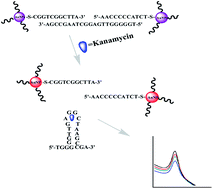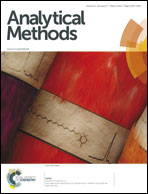Aptamer-based spectrophotometric detection of kanamycin in milk†
Abstract
Aminoglycoside antibiotics are widely used drugs. The residual antibiotics in animal-derived food are proven to be harmful to human health and therefore should be strictly controlled in the food industry. A spectrophotometric method based on a kanamycin-specific aptamer and gold nanoparticles (AuNPs) was developed for the quantitative detection of kanamycin. Two types of functionalized AuNPs were synthesized by self-assembly of thiol-modified single-stranded DNAs (ssDNAs), which were complementary to the 5′ terminal and 3′ terminal sequences of the kanamycin aptamer. As the kanamycin aptamer is mixed with these AuNPs, the AuNPs aggregate due to the hybridization of the aptamer with the complementary ssDNAs on the surface of AuNPs. However, when different concentrations of kanamycin are present, it can bind with the aptamer specifically and competitively, which leads to the disaggregation of the AuNPs aggregate, and a change in the UV-visible absorption spectrum of AuNPs. The absorbance at 527 nm is utilized to detect the concentration of kanamycin. The detection range of this method is 1–500 nM, with a detection limit of 1 nM. The developed method was then successfully employed to detect kanamycin in milk samples, and a similar response range and detection limit were obtained.


 Please wait while we load your content...
Please wait while we load your content...